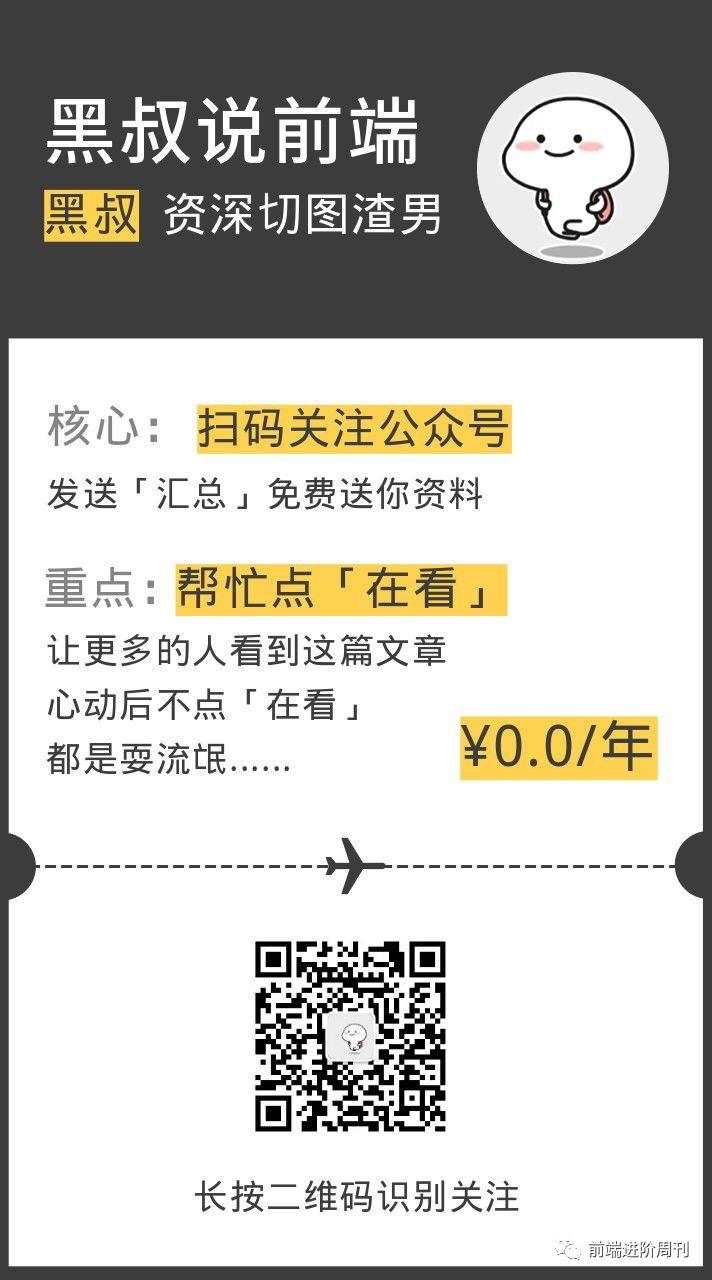点击上方“程序员黑叔”,选择“置顶或者星标”
你的关注意义重大!
作者 / WahFung
阅读本文需要 3分钟
路由参数解耦
一般在组件内使用路由参数,大多数人会这样做:
export default {methods: {getParamsId() {return this.$route.params.id}}
}
在组件中使用 $route 会使之与其对应路由形成高度耦合,从而使组件只能在某些特定的 URL 上使用,限制了其灵活性。
正确的做法是通过 props 解耦
const router = new VueRouter({routes: [{path: '/user/:id',component: User,props: true}]
})
将路由的 props 属性设置为 true 后,组件内可通过 props 接收到 params 参数
export default {props: ['id'],methods: {getParamsId() {return this.id}}
}
另外你还可以通过函数模式来返回 props
const router = new VueRouter({routes: [{path: '/user/:id',component: User,props: (route) => ({id: route.query.id})}]
})
文档:https://router.vuejs.org/zh/guide/essentials/passing-props.html
函数式组件
函数式组件是无状态,它无法实例化,没有任何的生命周期和方法。创建函数式组件也很简单,只需要在模板添加 functional 声明即可。一般适合只依赖于外部数据的变化而变化的组件,因其轻量,渲染性能也会有所提高。
组件需要的一切都是通过 context 参数传递。它是一个上下文对象,具体属性查看文档。这里 props 是一个包含所有绑定属性的对象。
函数式组件
{{item.title}}
{{item.content}}
父组件使用
(currentItem = item)" />
import List from '@/components/List.vue'
export default {components: {List},data() {return {list: [{title: 'title',content: 'content'}],currentItem: ''}}
}
文档:https://cn.vuejs.org/v2/guide/render-function.html#函数式组件
样式穿透
在开发中修改第三方组件样式是很常见,但由于 scoped 属性的样式隔离,可能需要去除scoped 或是另起一个 style 。这些做法都会带来副作用(组件样式污染、不够优雅),样式穿透在css预处理器中使用才生效。
我们可以使用 >>> 或 /deep/ 解决这一问题:
立即执行
watch 是在监听属性改变时才会触发,有些时候,我们希望在组件创建后 watch 能够立即执行
可能想到的的方法就是在 create 生命周期中调用一次,但这样的写法不优雅,或许我们可以使用这样的方法
export default {data() {return {name: 'Joe'}},watch: {name: {handler: 'sayName',immediate: true}},methods: {sayName() {console.log(this.name)}}
}
深度监听
在监听对象时,对象内部的属性被改变时无法触发 watch ,我们可以为其设置深度监听
export default {data: {studen: {name: 'Joe',skill: {run: {speed: 'fast'}}}},watch: {studen: {handler: 'sayName',deep: true}},methods: {sayName() {console.log(this.studen)}}
}
触发监听执行多个方法
使用数组可以设置多项,形式包括字符串、函数、对象
export default {data: {name: 'Joe'},watch: {name: ['sayName1',function(newVal, oldVal) {this.sayName2()},{handler: 'sayName3',immaediate: true}]},methods: {sayName1() {console.log('sayName1==>', this.name)},sayName2() {console.log('sayName2==>', this.name)},sayName3() {console.log('sayName3==>', this.name)}}
}
文档:https://cn.vuejs.org/v2/api/#watch
watch监听多个变量
watch本身无法监听多个变量。但我们可以将需要监听的多个变量通过计算属性返回对象,再监听这个对象来实现“监听多个变量”
export default {data() {return {msg1: 'apple',msg2: 'banana'}},compouted: {msgObj() {const { msg1, msg2 } = thisreturn {msg1,msg2}}},watch: {msgObj: {handler(newVal, oldVal) {if (newVal.msg1 != oldVal.msg1) {console.log('msg1 is change')}if (newVal.msg2 != oldVal.msg2) {console.log('msg2 is change')}},deep: true}}
}事件参数$event
$event 是事件对象的特殊变量,在一些场景能给我们实现复杂功能提供更多可用的参数
原生事件
在原生事件中表现和默认的事件对象相同
export default {methods: {inputHandler(msg, e) {console.log(e.target.value)}}
}
自定义事件
在自定义事件中表现为捕获从子组件抛出的值
my-item.vue :
export default {methods: {customEvent() {this.$emit('custom-event', 'some value')}}
}
App.vue
export default {methods: {customEvent(index, e) {console.log(e) // 'some value'}}
}
文档:https://cn.vuejs.org/v2/guide/events.html#内联处理器中的方法
https://cn.vuejs.org/v2/guide/components.html#使用事件抛出一个值
自定义组件双向绑定
组件 model 选项:
允许一个自定义组件在使用 v-model 时定制 prop 和 event。默认情况下,一个组件上的 v-model 会把 value 用作 prop 且把 input 用作 event,但是一些输入类型比如单选框和复选框按钮可能想使用 value prop 来达到不同的目的。使用 model 选项可以回避这些情况产生的冲突。
input 默认作为双向绑定的更新事件,通过 $emit 可以更新绑定的值
export default {props: {value: {type: Boolean,default: false}},methods: {switchChange(val) {this.$emit('input', val)}}
}
修改组件的 model 选项,自定义绑定的变量和事件
export default {model: {prop: 'num',event: 'update'},props: {value: {type: String,default: ''},num: {type: Number,default: 0}},methods: {numChange() {this.$emit('update', this.num++)}}
}
文档:https://cn.vuejs.org/v2/api/#model
监听组件生命周期
通常我们监听组件生命周期会使用 $emit ,父组件接收事件来进行通知
子组件
export default {mounted() {this.$emit('listenMounted')}
}
父组件
其实还有一种简洁的方法,使用 @hook 即可监听组件生命周期,组件内无需做任何改变。同样的, created 、 updated 等也可以使用此方法。
比如,在页面挂载时定义计时器,需要在页面销毁时清除定时器。这看起来没什么问题。但仔细一看 this.timer 唯一的作用只是为了能够在 beforeDestroy 内取到计时器序号,除此之外没有任何用处。
export default {mounted() {this.timer = setInterval(() => {console.log(Date.now())}, 1000)},beforeDestroy() {clearInterval(this.timer)}
}
如果可以的话最好只有生命周期钩子可以访问到它。这并不算严重的问题,但是它可以被视为杂物。
我们可以通过 $on 或 $once 监听页面生命周期销毁来解决这个问题:
export default {mounted() {this.creatInterval('hello')this.creatInterval('world')},creatInterval(msg) {let timer = setInterval(() => {console.log(msg)}, 1000)this.$once('hook:beforeDestroy', function() {clearInterval(timer)})}
}
使用这个方法后,即使我们同时创建多个计时器,也不影响效果。因为它们会在页面销毁后程序化的自主清除。
文档:https://cn.vuejs.org/v2/guide/components-edge-cases.html#程序化的事件侦听器
手动挂载组件
在一些需求中,手动挂载组件能够让我们实现起来更加优雅。比如一个弹窗组件,最理想的用法是通过命令式调用,就像 elementUI 的 this.$message 。而不是在模板中通过状态切换,这种实现真的很糟糕。
先来个最简单的例子:
import Vue from 'vue'
import Message from './Message.vue'// 构造子类
let MessageConstructor = Vue.extend(Message)
// 实例化组件
let messageInstance = new MessageConstructor()
// $mount可以传入选择器字符串,表示挂载到该选择器
// 如果不传入选择器,将渲染为文档之外的的元素,你可以想象成 document.createElement()在内存中生成dom
messageInstance.$mount()
// messageInstance.$el获取的是dom元素
document.body.appendChild(messageInstance.$el)
下面实现一个简易的 message 弹窗组件
Message/index.vue
// 默认选项
const DefaultOptions = {duration: 1500,type: 'info',content: '这是一条提示信息!',
}
let mid = 0
export default {data() {return {notices: []}},methods: {add(notice = {}) {// name标识 用于移除弹窗let _name = this.getName()// 合并选项notice = Object.assign({_name}, DefaultOptions, notice)this.notices.push(notice)setTimeout(() => {this.removeNotice(_name)}, notice.duration)},getName() {return 'msg_' + (mid++)},removeNotice(_name) {let index = this.notices.findIndex(item => item._name === _name)this.notices.splice(index, 1)}}
}
.wrap {position: fixed;top: 50px;left: 50%;display: flex;flex-direction: column;align-items: center;transform: translateX(-50%);
}.message {--borderWidth: 3px;min-width: 240px;max-width: 500px;margin-bottom: 10px;border-radius: 3px;box-shadow: 0 0 8px #ddd;overflow: hidden;
}.content {padding: 8px;line-height: 1.3;
}.message.info {border-left: var(--borderWidth) solid #909399;background: #F4F4F5;
}.message.success {border-left: var(--borderWidth) solid #67C23A;background: #F0F9EB;
}.message.error {border-left: var(--borderWidth) solid #F56C6C;background: #FEF0F0;
}.message.warning {border-left: var(--borderWidth) solid #E6A23C;background: #FDF6EC;
}
Message/index.js
import Vue from 'vue'
import Index from './index.vue'let messageInstance = null
let MessageConstructor = Vue.extend(Index)let init = () => {messageInstance = new MessageConstructor()messageInstance.$mount()document.body.appendChild(messageInstance.$el)
}let caller = (options) => {if (!messageInstance) {init(options)}messageInstance.add(options)
}export default {// 返回 install 函数 用于 Vue.use 注册install(vue) {vue.prototype.$message = caller}
}
main.js
import Message from '@/components/Message/index.js'Vue.use(Message)
使用
this.$message({type: 'success',content: '成功信息提示',duration: 3000
})
文档:https://cn.vuejs.org/v2/api/#vm-mount

亲,点这涨工资 